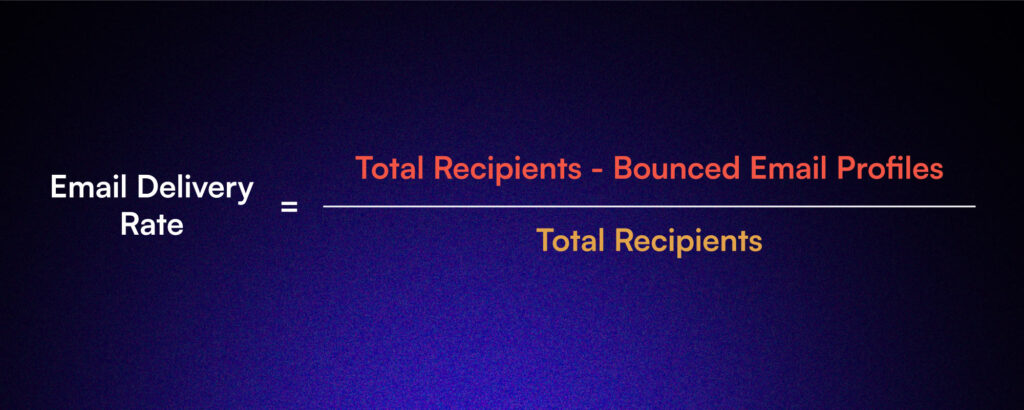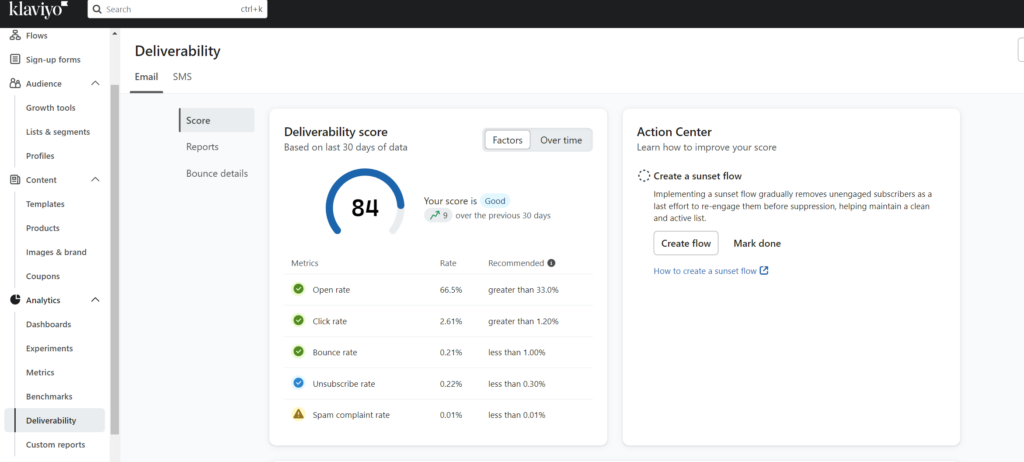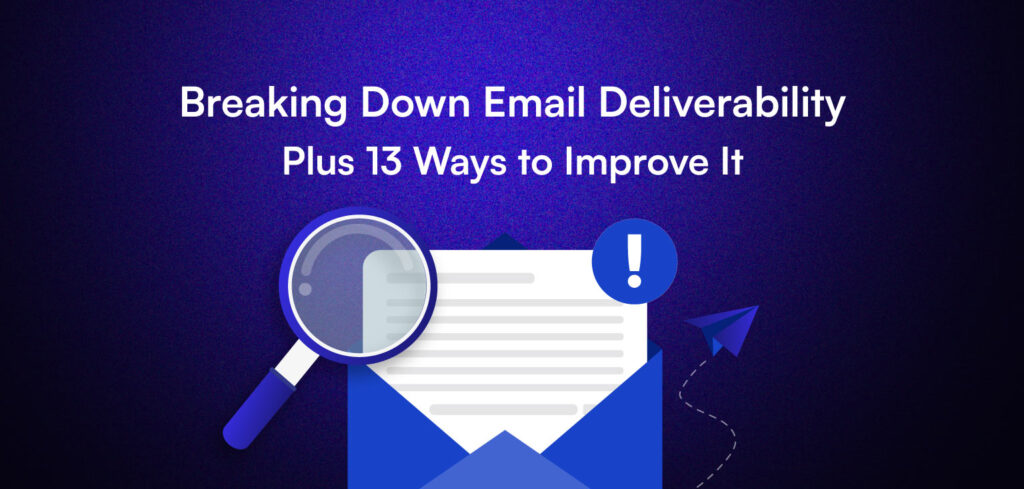If you’re in the business of email marketing, you probably know by now that getting your email into your recipient’s inbox is only half the battle.
That’s where email deliverability comes into play.
But what exactly is it, and why does it matter?
In this blog, we will explore this crucial aspect of email marketing.
What is Email Deliverability?
Email deliverability refers to the ability of an email to reach the inbox successfully. It’s not just about whether an email is sent, but whether it lands in the primary inbox, the promotional tab, or hopefully not the dreaded spam folder.
Email Deliverability vs. Email Delivery: What's the Difference?
While these terms might sound similar, they represent different concepts:

Email Delivery
Email delivery simply means that an email was accepted by the recipient’s mail server. It’s a binary outcome – either the email is accepted (delivered) or rejected (bounced). A successful delivery doesn’t guarantee the email will reach the inbox; it could still end up in spam or be filtered out.
In Klaviyo, the Email Delivery Rate is calculated as:

Email Deliverability
While often confused with delivery, email deliverability is a broader concept that focuses on where emails land once accepted by the mail server. Good deliverability means your emails consistently reach the primary inbox.
Klaviyo doesn’t directly measure inbox placement or provide a specific “deliverability rate.” This metric, which would show how many delivered emails end up in the inbox versus spam, is not typically available in most ESPs.
Deliverability is influenced by factors like sender reputation, email content, engagement rates, and technical aspects like authentication. While you can’t directly measure it in Klaviyo, focusing on improving your delivery rate, open rates, and engagement can positively impact your overall deliverability.
Does Email Deliverability Matter?
Absolutely! Here’s why:
- Reach: Higher deliverability means more of your subscribers actually see your emails.
- ROI: Better inbox placement leads to higher open rates and, potentially, more conversions.
- Sender Reputation: Good deliverability practices improve your reputation with ISPs, leading to better long-term performance.
Tracking Email Deliverability
Many Email Service Providers (ESPs) offer tools to monitor deliverability. For instance, Klaviyo provides users with a dashboard to easily track deliverability metrics.

Monitoring your deliverability performance over time is key to understanding how inbox providers may view your brand as a sender, and how likely you are to land in recipients’ main inbox.
Regularly monitoring deliverability can also help you quickly identify drops in performance, and mitigate potential deliverability issues before they have a large impact.
Key metrics to track:
- Open rates
- Click rates
- Bounce rates
- Spam complaints
Your performance with these metrics impacts your sender reputation and ultimately inbox placement rates.
These metrics will help you see the holistic view of your email campaign performance, allow you to identify any issues beforehand and take corrective measures to improve email deliverability.
Keep your email list clean by regularly removing inactive subscribers and engaging with your audience through relevant and personalized content.
If you are a Klaviyo user, you can utilize the Deliverability hub as a centralized space to analyze and diagnose your email deliverability health at the account level.
What is a Good Email Deliverability Rate?
While the ideal deliverability rate is 100%, that’s rarely achievable in practice. Generally, a rate of 95% or higher is considered excellent. However, anything below 90% suggests there’s room for improvement.
How to Test Email Deliverability
Testing email deliverability involves several steps:
1. Use seed lists
Send test emails to a list of email addresses across different providers. This involves creating a list of email addresses on various platforms (Gmail, Outlook, Yahoo, etc.) and sending your campaign to these addresses. This method helps you understand how your emails perform across different email clients and providers.
2. Monitor inbox placement
Check where your emails land (primary inbox, promotions, spam). This step is crucial as it directly impacts whether your subscribers will see your emails. Different email clients may categorize your emails differently, so it’s important to check across multiple platforms.
3. Use deliverability testing tools
Services like GlockApps or 250ok can provide detailed reports. These tools offer more comprehensive insights, including spam filter analysis, authentication checks, and even suggestions for improvement. They can simulate email sends to various providers and give you a clear picture of your deliverability status.
4. Analyze your metrics
Keep an eye on open rates, click-through rates, and bounce rates. These metrics can indirectly indicate deliverability issues. For instance, a sudden drop in open rates might suggest that your emails are landing in spam folders. High bounce rates could indicate list quality issues that need addressing.
What Affects Email Deliverability?
Several factors can impact your email deliverability:
- Images: Large or too many images can trigger spam filters.
- Naked Links: URLs not wrapped in hypertext can look suspicious.
- Number of Links: Too many links can flag your email as potential spam.
- SSL Certificate: A secure website builds trust with ISPs.
- CNAME: Proper domain authentication improves deliverability.
- Text Formatting: Excessive use of bold or all-caps text can trigger filters.
- Changing the “From Name” or Sender Name: Consistency builds trust.
- Switching ESPs: This can temporarily affect your sender reputation.
- Email Content: Spammy words or phrases can hurt deliverability.
- List Hygiene: Sending to inactive or invalid emails negatively impacts deliverability.
- Sending Frequency: Too many emails in a short time can trigger spam filters.
- Engagement Rates: Low open and click rates can hurt your sender reputation.
- IP Reputation: The reputation of your sending IP address affects deliverability.
How to Improve Email Deliverability
Now let’s get to the nitty-gritty. Here are 13 ways to improve your email deliverability:
1. Maintain a clean email list
Regularly remove inactive subscribers and invalid email addresses. This practice reduces bounce rates and improves engagement metrics. Consider implementing a re-engagement campaign for inactive subscribers before removal.
2. Use double opt-in
This ensures your subscribers genuinely want your emails. It adds an extra step to the subscription process but results in a more engaged list and reduces the risk of spam complaints.

3. Personalize your content
Relevant, personalized emails are more likely to be engaged with. Use subscriber data to tailor content, offers, and even send times to individual preferences.
4. Optimize your sending frequency
Find the right balance to keep subscribers engaged without overwhelming them. This may vary by segment – some subscribers might welcome daily emails, while others prefer weekly digests.
5. Authenticate your emails
Implement SPF, DKIM, and DMARC protocols. These technical measures prove to ISPs that your emails are legitimate, improving your chances of inbox placement.
6. Provide an easy unsubscribe option
This prevents subscribers from marking your emails as spam. Make sure the unsubscribe link is clearly visible and honors requests promptly.
7. Monitor your metrics
Regularly check your deliverability rates and other key metrics. Look for trends and anomalies that might indicate deliverability issues.

8. Warm up new IP addresses
Gradually increase your sending volume when using a new IP. This builds a positive reputation with ISPs over time, rather than raising red flags with sudden high-volume sends.
9. Test your emails
Use spam checking tools before sending to catch potential issues. These tools can identify content or design elements that might trigger spam filters.
10. Follow best practices for email design and content
Avoid spam trigger words and maintain a good text-to-image ratio. Keep your HTML code clean and ensure your emails are mobile-responsive.
11. Segment your list
Send targeted content to specific groups based on their interests or behaviors. This increases relevance and engagement, positively impacting deliverability.
12. Implement a preference center
Allow subscribers to choose the types of emails they receive and how often. This reduces the likelihood of recipients marking your emails as spam due to irrelevance or high frequency.
13. Use a consistent sender name and email address
This builds trust and recognition among your subscribers and ISPs.
Ready yet?
By focusing on these factors and continually optimizing your email practices, you can improve your deliverability rates and ensure your messages reach your subscribers’ inboxes. Remember, good deliverability is an ongoing process, not a one-time fix. Stay vigilant, keep testing, and always prioritize providing value to your subscribers.


